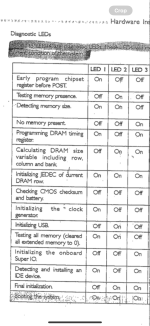My take on things:
First, when I look at the explanations for the various states of the diagnostic LED's, I do not see something that I expect, which is some sort of verification of the BIOS ROM's integrity.
'
Testing memory presence' and '
Detecting memory size' are sure to be the POST interrogating the motherboard RAM using 'presence detect'.
From that, the POST knows what motherboard RAM is present, and what ranges of timing are valid for the motherboard RAM that has been fitted.
More information at [
here].
If no motherboard RAM is detected, maybe the POST will halt at the '
No memory present' status.
If motherboard RAM detected, the POST then goes on to:
1. Set the diagnostic LED status to '
Programming DRAM timing register'.
2. Configure the motherboard's chipset for DRAM timing that is suitable for the fitted motherboard RAM.
So, with the status stopped at '
Programming DRAM timing register', could it be that:
- The chipset's timing register supports read-back testing, and the POST's test of the timing register failed?; or
- Damaged BIOS ROM contents?; or
- BIOS ROM contents good, but BIOS ROM needs to be re-seated in its socket due to poor contact (e.g. affecting an address pin)?


